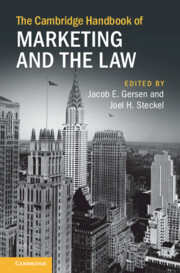Book contents
- The Cambridge Handbook of Marketing and the Law
- The Cambridge Handbook of Marketing and the Law
- Copyright page
- Dedication
- Contents
- Figures
- Tables
- Contributors
- Introduction
- Part I Understanding Consumer Behavior
- Part II Understanding Marketing Phenomena
- 5 The Persistence of False Reference Prices
- 6 Brand Value, Marketing Spending, and Brand Royalty Rates
- 7 On Puffery
- 8 Search Engine Advertising, Trademark Bidding, and Consumer Intent
- Part III Methodological Advances
- Part IV How the Law Protects
5 - The Persistence of False Reference Prices
Theory and Empirical Evidence
from Part II - Understanding Marketing Phenomena
Published online by Cambridge University Press: 29 June 2023
- The Cambridge Handbook of Marketing and the Law
- The Cambridge Handbook of Marketing and the Law
- Copyright page
- Dedication
- Contents
- Figures
- Tables
- Contributors
- Introduction
- Part I Understanding Consumer Behavior
- Part II Understanding Marketing Phenomena
- 5 The Persistence of False Reference Prices
- 6 Brand Value, Marketing Spending, and Brand Royalty Rates
- 7 On Puffery
- 8 Search Engine Advertising, Trademark Bidding, and Consumer Intent
- Part III Methodological Advances
- Part IV How the Law Protects
Summary
A general premise of consumer protection is that greater consumer information and more competition in a market should increase the tendency of firms to behave fairly and honestly.1 In the case of deceptive promotional pricing, greater consumer information comes from having more consumers in the market being attentive to and knowledgeable of reference promotional pricing (i.e. showing a regular price along with the sales price).
- Type
- Chapter
- Information
- The Cambridge Handbook of Marketing and the Law , pp. 105 - 148Publisher: Cambridge University PressPrint publication year: 2023

